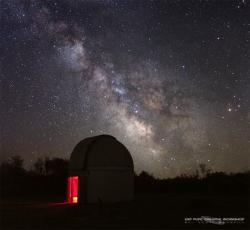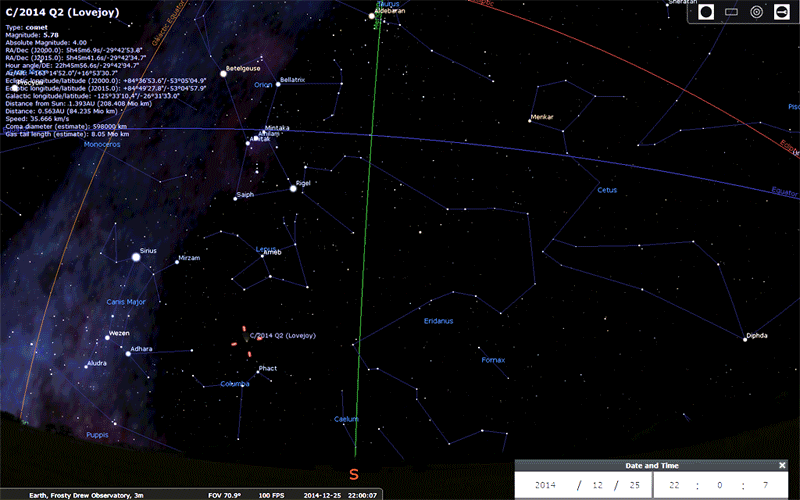
Public Stargazing
- Where:
- Frosty Drew Observatory
- When:
- Friday December 19, 2014 at 6:30 p.m.
- Cost:
- $1 Suggested Donation per Person
Tonight's forecast is calling for mostly clear skies with a slight chance of clouds and temps dipping into the mid 20's. This is quite fortunate as the super thin 3% waning crescent Moon will not rise until 5:25 a.m. offering us fabulously dark skies to revel in the late Autumn starscape over Frosty Drew.
We plan to open the Observatory and Sky Theatre at 6:30 p.m. In the Observatory, telescopes will showcase an impressive list of nebulae, galaxies, star clusters, binary stars, Uranus, and Jupiter. The Sky Theatre will be toasty warm with videos, slide shows, and possibly live telescopic views of Winter celestial objects on display. Dress warm, winter coats, hats, gloves, and warm shoes will make the difference between a fun night under the stars and freezing your pants off. Also, dressing in loose fitting, overlapping layers will keep you significantly warmer.
We have had some excellent nights at Frosty Drew this Autumn and tonight looks to be another one! Make tonight the night you make your discovery of the Universe at Frosty Drew.
-------------------------------------------------------------------------
Weekly Happenings
Scott MacNeill
On Sunday, December 21, 2014 at 6:03 p.m. EST the Winter Solstice will occur, marking the start of the Winter season. The Winter Solstice is the point when Earth's axis is most inclined away from the Sun in the Northern Hemisphere and most inclined toward the Sun in the Southern Hemisphere. This will cause Earth's celestial equator to rise 23.4° above the Ecliptic, which is the path the Sun takes through the sky and represents the plane of the Solar System. During the Winter Solstice those residing on the Tropic of Capricorn will see the Sun at zenith (directly overhead) during midday and the Antarctic Circle will experience 24 hours of sunlight with the Sun dropping to the horizon at midnight, hailing the Midnight Sun. Consequently the Arctic Circle will see near 24 hours of darkness with the Sun just barely rising to the horizon during midday.
All that aside, the Winter Solstice brings us the long cold of Winter, festive Holiday lights, Smoking Bishop, much Dickens goodness, and the merriment of time spent with friends as the height of our Winter celebrations and the final approach to the end of the year come together.
Among all the awesome things happening during the start of the Winter season and the coming New Year, we have an excellent addition coming to the Northern Hemisphere sky this Winter. Comet C/2014 Q2 (Lovejoy) will be rising higher every night for all of us Northern Hemisphere residents, and may become naked eye visible just after the turn of the year.
Comet Lovejoy was discovered on August 17, 2014 by comet hunter, Terry Lovejoy and is considered a long period comet. Historically C/2014 Q2 had an orbital period around the Sun of about 11,500 years. Though its current encounter with the Sun will alter its orbit, resulting in a period adjustment of 3,500 years. After leaving the planetary region of the Solar System, Lovejoy's orbital period will be reduced to about 8,000 years. En route to the Sun, Lovejoy will pass Earth on January 7th at 43,600,000 miles distant. Then on January 30th,, Lovejoy will achieve perihelion (its closest point to the Sun) at a distance of 119,912,991 miles. Which is 1.29 times the distance the Earth is from the Sun.
At Frosty Drew Observatory, we will begin our observation of C/2014 Q2 just after Xmas. As we move into the New Year, the comet will continue to rise higher in our skies as well as brighten up. We expect Lovejoy to be a regular target in the weeks to come that will continue to mesmerize Frosty Drew visitors through the month of January and perhaps longer. Get out there this Winter and check out what could be a beautiful naked eye comet.
All of us astro-geeks at Frosty Drew Observatory are hoping you have a Happy Winter Solstice and a fabulous New Year!

-Scott

